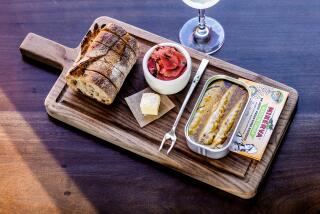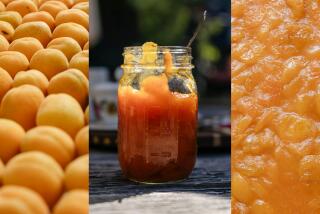YELLOW FEVER
- Share via
THERE ARE SOME THINGS MONEY CAN’T BUY. Love. Talent. Happiness. And, in Southern California, the preserved lemon. I found this out the hard way.
The last time I was in Paris, in a Moroccan restaurant in the Latin Quarter, I’d eaten an unforgettable lamb tagine with green olives and finely shredded preserved lemon.
Preserved lemon is nothing more than the fruit cured in salt and lemon juice until the pulp acquires an almost jellied consistency. Miraculously, the bitterness vanishes and the rind softens, becoming translucent and tender. The result is a concentrated, intensified lemon flavor, with sourness and saltiness hitting a perfect pitch.
In Moroccan cooking, the preserved pulp is often scraped out and cooked into the sauce of the tagine or stew, and the rind is chopped or cut into strips and added at the end of the cooking. In Southern California, I’ve discovered chefs putting this lively condiment to their own creative uses. Lee Hefter at Spago often pairs preserved lemon with seafood--preserved Meyer lemon accents fresh Nantucket scallops; a few enlivening threads of rind top a fresh pea soup with peeky toe crab. At Lucques, Suzanne Goin makes her own chicken tagine with olives and preserved lemons; she also chops the whole preserved lemon, again with green olives, to make a chutney for grilled fish. Recently, at Le Petit Zinc, a French bistro in Santa Monica, I tried branzino with thin slices of preserved lemon arranged simply on top.
Back home, I resolved to re-create the Moroccan dish for friends. A dinner party was scheduled. The day before, I bought the lamb, olives, onions, spices, couscous for a side dish, even fresh mint for tea afterward. I didn’t buy preserved lemon because I couldn’t find it anywhere. I found dried limes in the Middle Eastern stores, lime and lemon pickle in Indian food stores, dried lemon zest at my local supermarket. But these counterfeits lack that addictive salty-sour pungency of the North African condiment. The day of my dinner party, I returned empty-handed from the stores. I got on the phone, appealing to friends who cooked. “I saw some preserved lemons in a shop,” said my friend Emily, “in London.” Other friends also did not know where to buy preserved lemon, but they did commiserate with my mounting panic. “This reminds me of the day I decided to wallpaper the dining room for a dinner party that night,” said one. “This brings to mind the time a 3-year-old boy ate all the meringue off of two lemon meringue pies,” said another. “And I had no more eggs and the stores were closed.”
So the day of my dinner party, I was out of luck. There was nothing to do but make my own for the next time. And, blessedly, there’s nothing easier. Buy a bag or two of lemons, a box of kosher salt and scrounge up a few wide-mouth jars. Assemblage is rather fun--pack coarse salt into quartered lemons, pile in jars and cover with lemon juice. (Depending on the lemons, up to half of them may be needed for juice--the lemons must be completely submerged.) The results are visually beautiful from the get-go: sunny yellow orbs in a slightly fuzzy, translucent liquid, steeping, steeping. The bad news is preserved lemons need to cure for one month.
The moral of this tale is be sure to make enough for friends who call you in a last- minute frenzy. If the trend-spotters are correct, the demand for preserved lemons will only increase exponentially. Maybe I should go into business.
In the meantime, set the lemon-packed jars someplace warm, where you can also admire their sunny beauty. Preserved lemons are definitely an exercise in delayed gratification. But, oh, what gratification.
PRESERVED LEMONS
Makes 12 lemons
12 large lemons
1/2 cup kosher sea salt
Freshly squeezed lemon juice, as needed
*
Slice lemons into quarters, leaving stem end intact so that lemons will hold together. Rub and pack two teaspoons of salt into flesh of each lemon, then re-form lemon and place in a Mason jar. Continue process with remaining lemons. Press down on lemons as you add to jar to release juices. Then fill jar with lemon juice to cover lemons, leaving a bit of air at top before sealing. Allow lemons to cure in a warm space for about a month. With a spoon, carefully remove any mold that forms. When ready to use, remove a lemon from jar and rinse. Store remaining lemons in refrigerator.
More to Read
Eat your way across L.A.
Get our weekly Tasting Notes newsletter for reviews, news and more.
You may occasionally receive promotional content from the Los Angeles Times.










